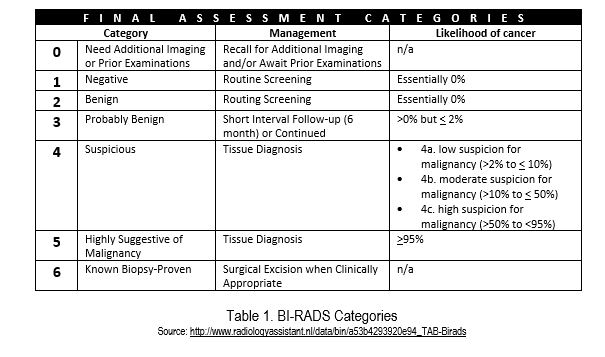New Analytics Approach Offers Potential of Reducing Unnecessary Breast Biopsies
– Publication in AJR defines advanced statistical methods that can be used with diagnostic imaging output to downgrade breast mass risk classification –
SAN ANTONIO, May 3, 2018 – The American Journal of Roentgenology recently published findings on statistical methods for downgrading the risk classification of breast masses to reduce the need for unnecessary breast biopsies. Clinicians from Seno Medical and medical center collaborators from The University of Texas co-authored the report.1
“The perceived risk of missing a breast cancer diagnosis with breast imaging studies is much higher than the risk of a false-positive diagnosis, leading to breast imagers recommending a breast biopsy whenever the risk of cancer is greater than 2%. Sometimes ancillary diagnostic breast imaging studies are performed to reduce risk to less than 2%, but it is difficult to know exactly how much risks are reduced even after a negative ancillary diagnostic imaging examination,” said Thomas Stavros, MD, Chief Medical Officer of Seno Medical and a co-author of the report. “However, the use of the Negative Likelihood Ratio (NLR) along with BI-RADS 4 subcategories can help to reduce the number of false-positives without experiencing excessive negative results that would lead to cancer going undiagnosed.”
The report explores the use of a statistical calculation known as the Negative Likelihood Ratio (NLR). It shows how NLR can be calculated from a diagnostic test’s sensitivity and specificity and also show the NLRs of some currently available diagnostic imaging modalities. It outlines how the BI-RADS (Breast Imaging and Reporting Data System, or BR) 4A sub-category has low enough and narrow enough range of pre-test probabilities (see Table 1) to allow downgrading to a post-test probability of 2% or less after a negative diagnostic imaging test with an adequately low NLR.

Each BI-RAD category is associated with a specific risk of breast cancer. Briefly, the approach includes the following steps:
- Classify lesions according to BI-RADS category 4 subcategories. Subcategory 4A is important as it represents the subcategory where the range of PPVs is both low enough and narrow enough to allow downgrading to BI-RADS category 3 is most possible when a diagnostic imaging test result is negative.
- Confirm that the Positive Predictive Value (PPV) is within the American College of Radiology (ACR) benchmark PPV range for BI-RADS subcategory 4A (>2% to 10%).
- Ensure the NLR is adequate for a negative test finding to reduce the post-test probability to 2% or less.
“Reducing the number of unnecessary breast biopsies is an essential advancement toward improving women’s healthcare and protecting breast health,” said Pam Otto, M.D., Department of Radiology, The University of Texas Health Science Center at San Antonio and co-author. “I would encourage breast imagers to consider using BI-RADS 4 subcategories and NLR as important tools for helping them minimize false positive studies with minimum adverse effect on sensitivity, optimizing their patients’ breast health. The availability of web-based programs for automating the NLR calculations should help to facilitate routine use of this important statistical tool.”
About Seno Medical Instruments, Inc.
Seno Medical Instruments, Inc. is a San Antonio, Texas-based medical imaging company committed to the development and commercialization of a new modality in cancer diagnosis: opto-acoustic imaging. Seno Medical’s Imagio™ breast imaging system fuses opto-acoustic technology with ultrasound (OA/US) to generate fused real-time functional and anatomical images of the breast. The opto-acoustic images provide a unique blood map around breast masses while the ultrasound provides a traditional anatomic image. Through the appearance or absence of two hallmark indicators of cancer – angiogenesis and deoxygenation – Seno Medical believes that the Imagio OA/US breast imaging system will be a more effective tool to help radiologists confirm or rule out malignancy than current diagnostic imaging modalities – without exposing patients to potentially harmful ionizing radiation (x-rays) or contrast agents. To learn more about Seno Medical’s OA/US imaging technology and applications, visit www.SenoMedical.com.
[1] Yang WT, Parikh JR, Stavros AT, Otto P and Maislin G. Exploring the Negative Likelihood Ratio and How It Can Be Used to Minimize False-Positives in Breast Imaging. AJR 2018;210:301-306.
